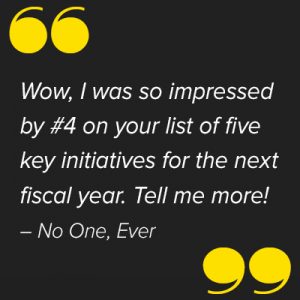
Let’s pretend you’re a senior executive at a cocktail party during your company’s conference.
Earlier today, you gave a 20-minute speech from the main stage that outlined your plans for the coming year. Your colleagues said you did great, but you’re mostly just relieved the presentation is over.
So now you’re enjoying a chipotle mango chicken skewer and a well-deserved drink, and you’re hoping to hobnob with a few conference participants before you escape to the sanctuary of your hotel room.
Ah-ha! Here come some attendees now. They introduce themselves and shake your hand. Then they kick off the conversation.
What will they say to you?
To level-set, at many conferences, top leaders can achieve borderline celebrity status. Like corporate rock stars. It requires hutzpah for attendees to work up the nerve to speak to an executive. Hopefully they can remember SOMETHING about your speech from earlier today to use in the approach.
What did you say earlier? Will anyone remember? Do you remember?
It’s only been a few hours, but if the content of your speech contained only goals, facts and figures, my bet is the opening line will sound something like this:
“Great job today! I’m really enjoying the meeting.”

Because, well, that’s all they can think to say to you.
They can’t remember much about your 20 minutes on stage. Most conference speeches from corporate executives are not very memorable.
Unless you tell a personal story.
Carefully selected personal stories are game changers when you’re trying to connect with an audience and deliver an impactful message.
Embedding a personal story in your business presentation accomplishes several objectives:
- A hook. Personal stories, when told well, capture the attention of the audience. Most of the time, when a non-professional speaker is on the docket, audience expectations are low. They anticipate a boring speech. Their eyes begin to glaze over even before the emcee has finished reading your title. However, you can leap adeptly over this very low bar simply by starting your speech with an interesting story that seemingly has nothing to do with your industry or topic. Suddenly, listeners are jostled from their conference comas.
- Relatability. An invisible line forms between a speaker and the audience. It’s not your fault. The very layout of a ballroom automatically creates a dichotomy of you versus them. You’re on stage. You’re the one with a microphone. Clearly you hold the power. Bridge the gap by telling a relatable story that proves you, too, are a real person.
- Stickiness. If the point of hosting a conference is to send attendees home with valuable information, a renewed pride in the company and excitement over its future and leadership, you’ve missed a big opportunity when the audience can’t remember a single thing you said. Help them out. Pick an entertaining story from your life and then relate that story back to the primary point of your speech. This tactic will not only engage attendees, but it will also help them remember your message.
- Personal branding. A speech should be more than the audiobook version of your company’s business plan. It should be a reflection of who you are as a person. Being on stage offers an opportunity to create or improve your personal brand and showcase the kind of leader you are. Don’t squander the chance to demonstrate to the audience the values you hold, where you came from, the lessons you’ve learned and the experiences that make you uniquely you. The audience is curious about the human behind the headshot. What makes you tick? Give the people what they want.
But my message is about the business … not about me.
When I meet with new clients to discuss their content and suggest kicking off the speech with a personal story, some leaders worry out loud that they’ll sound self-absorbed. At the root of this objection is a delightful bit of humility … and usually also a tiny bit of fear.
“No one tells personal stories at my company. It’s not what we do. I want to toe the line. Could I just add in an inspirational quote from somebody famous or something?”
For the love of all things holy, no.
I’m already asleep, and we haven’t even started writing your speech yet.
After all, just because you have a captive audience doesn’t mean they should feel captured. Aim to captivate them instead.
And if no one else in your company tells personal stories, that’s all the more reason for you to do it. You’ll stand out.
If you master the art of storytelling, you’ll get asked to speak more often, which means more people will learn about you and hear your message. You’ll be top-of-mind when new leadership positions become available.
Storytelling is a skill that will advance your career.
I’ve witnessed good storytellers leapfrog past unmemorable colleagues time and time again.
Okay, I’ll consider a personal story. Where do I start?
Shameless plug time: I encourage you to contact me as your first step. Helping leaders tell their stories is my all-time favorite job here at Thinkwell. The work brings me joy. If you’d like my help, please reach out.
That said, I’m so passionate about convincing people to insert stories into their speeches that I’ll gladly share my “secret” recipe here for how to do it.
First, make a list of the important pieces of content that your attendees need to know. Include your business objectives as well as your personal objectives. Then prioritize each point.
Next, identify the very most important point … the one that answers this proverbial question: “If listeners don’t remember anything else, what’s the one thing you want them to remember?”
Finally, brainstorm events from your own life that could illustrate that most important point. Pick the most engaging, touching, inspiring, unusual or funny story. Then write about that experience, usually at or near the beginning of your speech.
Can you share an example?
Sure thing.
(Note: I’m sharing this story with permission from the client. I’ve changed her name and a few details.)
The background: Sarah recently became the SVP of a well-known consumer brand. Her predecessor is a beloved leader who has built the brand to its current status.
The challenge: How should Sarah introduce herself to this audience for the first time, honor the good work the former leader has done while also demonstrating she is not his carbon copy, and assure nervous stakeholders that her goal as the new SVP is to continue and even amplify the brand’s trajectory of success?
The solution: A personal story that ties together all of these critical talking points.
The story: Sarah, her siblings and their children participate in a fun family tradition every year. From their homes across the country, Sarah’s family members follow major horse racing competitions, placing nominal bets with each other about which horse will win each race. The winner receives a small pot of money and big-time bragging rights. This past year, Sarah’s young daughter participated in the family game for the first time and, incredibly, wound up winning the whole thing! Sarah’s daughter bet on the winner—and not just any winner, but the horse who won the Triple Crown (the incredibly rare honor bestowed to a horse who wins three critical races in a row). A photo of Sarah’s daughter with a huge grin appears on the screens.
Sarah uses that example to explain how, in her professional life, she’s betting on a winner, too, by joining this brand that continues to win awards year after year. Just like in horse racing, winning in business requires discipline, hard work and a keen eye on the competition … and that’s just what the audience should expect from Sarah as she leads this amazing brand into the future. Sarah then proceeds to outline her plans to continue the brand’s winning streak.
The result: Sarah nails her presentation. She comes across poised, confident and prepared. Sarah wins the audience over with a story about a quirky family tradition, and she delivers her message in such an engaging way that listeners physically lean in toward her. Sarah shows the audience that she is an accomplished, brilliant and strategic leader … and also a fun-loving mother, wife and sister.
After the speech, attendees line up to chat with Sarah.
- “I love horses, too!”
- “Watching horse races with your family is such a cool idea – I’m going to see if I can convince my brothers to start a family pool next year.”
- “I have a five-year-old at home, too! What did your daughter do when she found out she had won?”
- “I just wanted to introduce myself and tell you how excited I am that you’re leading the brand.”
The epilogue: Sarah told that particular story from the stage about five years ago. She pulled me aside recently and marveled that people still come up to her and talk to her about horse racing. One audience member even offered Sarah his tickets to the Kentucky Derby so she could take her daughter.
But I don’t know the first thing about horse racing.
Well, good, because that’s Sarah’s story. Think of something from your own life experience.
The options are limitless.
Case in point? Here are a few other fascinating stories from leaders I’ve worked with: his inspiring grandfather who lost a business during WWII … the antics of the speaker himself when he was a young punk … lessons learned from when she was a high school cheerleader … how his bride helped him rediscover how to fall in love … a bicycle crash when he was a child … her unpopular opinion that parenting teenagers is actually (usually) fun.
The list goes on and on.
So what’s your story?
Will you join me in the fight for more interesting, memorable and impactful conference speeches?
The return on investment (ROI) is hefty. You’ll give the audience an interesting personal story to relate to, you’ll make your message “stickier” and easier to remember, and you’ll stand out from your peers.
Sprinkle some humanity into your script and become a conference hero.
See you backstage!
















